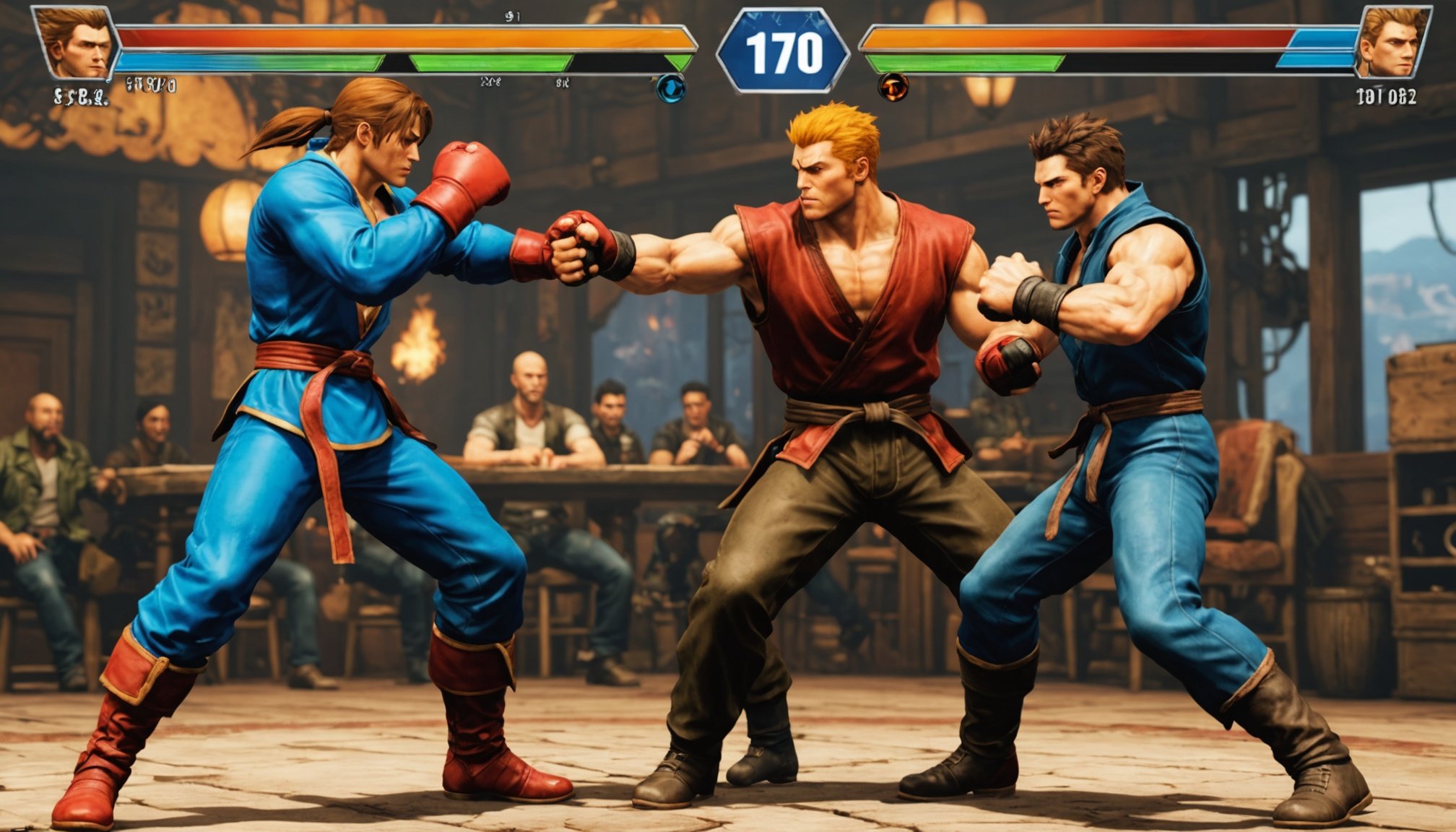Understanding Character Fairness in Fighting Games
In the realm of fighting games, fairness primarily relates to character balance. Every character in a game should embody strengths and weaknesses equivalent to others, ensuring no single character possesses a dominating advantage. This balance is crucial for maintaining gameplay fairness, which directly impacts the competitive integrity and overall player experience.
A robust balance upholds competitive integrity, offering an even playing field where skill truly defines outcomes. For players, a balanced game means more enjoyable gameplay as victories and defeats are attributed to personal proficiency rather than inherent character imbalances.
Also read : Navigating Cosmic Challenges: Breaking Down Real-World Physics Barriers in Space Simulation Games
Historically, popular fighting games have wrestled with character imbalance issues. Titles like “Street Fighter II” debuted with characters like Sagat and Ryu who were perceived as overpowered, driving substantial tweaks and updates. Meanwhile, Super Smash Bros grappled with characters like Metaknight, which challenged balance measures and influenced game patching and adjustments over time.
Understanding and addressing these imbalances isn’t just pivotal for current play; it informs the development of future iterations, pushing for nuanced designs that promise gameplay fairness and competitive excellence.
In the same genre : Mastering Console Gaming: Proven Techniques to Reduce Input Lag and Boost Your Competitive Advantage
Strategies for Developers to Achieve Balance
Creating balanced characters in fighting games is a meticulous task, rooted in key game design principles. Developers begin with defining core traits and abilities, ensuring each character contributes uniquely without overshadowing others. This involves designing characters with comparable strengths and weaknesses. Clear distinction in roles can help maintain gameplay fairness.
A crucial part of balancing strategies is continuous assessment and iteration. Developers must rely on player feedback to identify imbalance. Utilising data analytics plays a significant role here. By analysing match data, developers can monitor character performance effectively, pinpointing imbalances before they detract from competitive integrity.
Moreover, developers often use patches and updates to fine-tune character balance post-launch. Drawing lessons from industry concerns, many developers adopt a collaborative approach, involving their community in balancing strategies. Constant iteration based on broad feedback helps in crafting a more refined gaming experience.
Sophisticated balancing remains a vital pillar for the success of fighting games. As the gaming landscape evolves, the fusion of technology and player input continues to drive innovation in developer techniques for character fairness. Balanced characters not only attract enthusiastic participation but also foster long-lasting player engagement.
Player Strategies for Mastering Balanced Gameplay
Successfully navigating the world of balanced play in fighting games requires strategic adaptability and keen character selection. Players should focus on understanding each character’s distinct abilities and learning to adapt to changing scenarios. Mastering player tactics can be achieved by dedicating time to study not just the strengths but also the vulnerabilities of characters chosen during matches.
A vital aspect of competitive gameplay involves developing counter-strategies. This means recognising and adapting to encounters with imbalanced characters. When facing opponents who exploit a character’s dominant traits, adept players should assess the situation and refine their strategies, leveraging inherent weaknesses in those seemingly overpowered characters.
Practice is indispensable for developing proficiency in character dynamics. Regular training sharpens the skills necessary to utilise a character’s strengths and weaknesses effectively. Dedicated sessions can simulate real match conditions, empowering players to react instinctively during actual competitive play.
For true mastery, players should embrace continuous improvement by engaging in training modes and utilising community feedback. This fosters insightful learning and builds a self-sustained growth loop in becoming adept at mastering balanced gameplay. Understanding these elements can significantly enhance player performance in competitive settings.
Case Studies of Balanced vs. Imbalanced Characters
Exploring case studies offers valuable insights into achieving character balance. This section will delve into the intricacies of game examples, examining how balance or imbalance affects gameplay and community engagement.
Case Study: Street Fighter Series
The Street Fighter Series serves as a classic example. Notably, characters like Sagat and Ryu initially presented imbalance challenges, prompting revisions to attain fairness. Such historical imbalances necessitated corrective measures, underpinning future designs that ensured more balanced gameplay. Continuous character analysis evolved the series, aligning it with competitive expectations and maintaining its enduring popularity.
Case Study: Super Smash Bros
In Super Smash Bros, Metaknight epitomised imbalance, causing significant community discussion. This case highlighted the effects of character oversights on competitive dynamics. Adjustments and patching were integral to realigning player dynamics and enhancing gameplay fairness. The lessons learned catalysed more meticulous approach in future iterations.
Case Study: Tekken Series
The Tekken Series illustrates success in balance. Its characters, through systematic updates, exemplify harmony. Persistent monitoring and game examples illuminated effective strategies, bolstering player engagement and community support. The insightful lessons underscore the importance of balance and adaptability, crafting a framework for future titles to emulate.
Expert Opinions on Character Fairness
In the pursuit of game balance, expert insights play a pivotal role. Interviews with game developers and professional players illuminate key strategies adopted to maintain balance in fighting games. These experts often emphasise the delicate equilibrium necessary between character strengths and weaknesses, advocating for balanced design principles that support both competitive integrity and player enjoyment.
Industry opinions frequently highlight the significance of community engagement in refining character balance. Developers rely on feedback loops from passionate players to fine-tune gameplay elements, ensuring that their balancing strategies remain dynamic and responsive to the evolving gaming landscape.
Future outlooks on balancing methodologies suggest further integration of data analytics and artificial intelligence. By leveraging advanced technologies, developers can anticipate imbalances and implement real-time solutions, thus preserving fairness. Such technological strides promise to redefine how character assessment occurs, offering innovative paths to maintain and enhance gameplay equality.
By understanding and integrating these industry perspectives, fighting game developers can continue to craft titles that resonate with competitive players. As game design evolves, staying attuned to expert insights remains indispensable for fostering balanced and engaging environments.
Practical Examples of Balanced Gameplay in Action
Exploring gameplay examples in tournaments offers a window into the real-world application of balanced character play. Competitive matches often spotlight tournament strategies that effectively highlight character balance and fairness. These matches reveal how top players capitalise on character strengths while mitigating weaknesses, underscoring the strategic nuance necessary for success.
In such settings, the adaptability of players is crucial. A key component involves seamlessly shifting strategies based on opponent behaviours and character dynamics. Players often adjust their approaches mid-game, highlighting an in-depth understanding of balance.
Successful players in competitive settings frequently display an adaptable mindset. They maintain awareness of both their character’s capabilities and the capabilities of opposing characters. This adaptability extends beyond mere in-game mechanics to include keen observational skills, aiding in predicting and counteracting opponent strategies.
Real-world application of balanced gameplay also involves consistent practice, as this builds a strong foundation for character mastery. This practice enhances a player’s ability to deploy strategies intuitively during a match. Ultimately, embracing flexibility and an informed mindset determines success in leveraging balanced characters effectively in competitive arenas.
Tips for Competitive Play in Fighting Games
Navigating the intense world of fighting games requires strategic finesse and adaptability. To succeed in competitive play, players need a nuanced grasp of gameplay strategies. An essential first step is building a diverse character roster. This ensures readiness for various scenarios and allows players to exploit different matchups effectively.
Utilizing training modes is another indispensable strategy. These modes offer players a controlled environment to explore each character’s strengths and weaknesses, deepening their understanding of character fairness. Training sessions enable players to simulate match conditions, honing their skills in anticipation of real competitive environments.
Accessing community resources is a powerful way to amplify skills. Engaging with forums, discussion groups, and video analyses can provide valuable insights into gameplay strategies that might not be apparent just by playing. This community engagement fosters a supportive network for continuous improvement and player advice.
Additionally, consistency in practice and situational awareness can greatly enhance performance. Regularly training and maintaining a positive and adaptive mindset are crucial for mastering the dynamic landscape of fighting games, leading to sustained competitive success.






